
The Project Gutenberg EBook of Metropolitan Subway and Elevated Systems, by
General Electric Company
This eBook is for the use of anyone anywhere at no cost and with
almost no restrictions whatsoever. You may copy it, give it away or
re-use it under the terms of the Project Gutenberg License included
with this eBook or online at www.gutenberg.org/license
Title: Metropolitan Subway and Elevated Systems
Bulletin 49
Author: General Electric Company
Release Date: January 18, 2017 [EBook #54009]
Language: English
Character set encoding: UTF-8
*** START OF THIS PROJECT GUTENBERG EBOOK METROPOLITAN SUBWAY ***
Produced by Juliet Sutherland, ellinora and the Online
Distributed Proofreading Team at http://www.pgdp.net

The transportation system of the city of Boston comprises a combination of both rapid transit and surface lines operated under a single fare arrangement with transfer privileges permitting a continuous ride in one general direction from one end to the other of the system. The elevated lines and the Tremont St. Subway were originally built by the railway company in 1901. Today the total transportation system includes more than 500 miles of line of which 37 miles are subway and elevated tracks. The population served in the district of more than 92 square miles is considerably over a million people and the number of revenue passengers carried, approximates 350,000,000 per year. Statistics are not available as to the passengers carried on the Rapid Transit lines.

Exterior of Main Power Station at South Boston
The original elevated structure operated between Sullivan Sq., Charlestown, and Dudley Street, with two branches through the city, one by subway under Tremont St. and the other by the way of Atlantic Ave. and South Station. In 1908-9 the elevated structure was extended to the present terminal at Forest Hills and the Washington St. Subway was completed through the business part of the city. The Cambridge Subway was placed in operation in 1912. Recent extensions include an elevated line from Sullivan Square to Everett and reconstruction of the tunnel to East Boston.
Since July 1, 1919, the system has been operated by the Board of Trustees of the Commonwealth. Under the direction of this board are included not only the details of operation and management, but also the decisions as to fares to be charged independent of the State Department of Public Utilities.
Under the direction of the present management a continuous program of improvements has been inaugurated which has necessitated the re-routing of trains to handle the traffic to the best advantage.
Briefly there are four main routes as follows:
| Forest Hills-Everett (via tunnel) | 8.59 miles |
| Forest Hills-Everett (via elev.) | 9.35 miles |
| Harvard-Andrew | 5.56 miles |
| No. Station West-Kenmore | 2.87 miles |
| Bowdoin-Maverick Sq. | 1.67 miles |
3The Forest Hills-Everett route is called the main line, and the Harvard-Andrew route the Cambridge Subway. The Bowdoin-Maverick Square line up to the present has been operating three-car trains with overhead trolley, but new equipment consisting of steel cars is now on order and the third rail is now being installed in the tunnel. The Lechmere Sq.-Broadway line over East Cambridge Viaduct and Tremont St. Subway is also considered a rapid transit route, although surface type cars are used with overhead trolley. These cars are equipped for multiple unit control and are operated in three-car trains.

35,000-Kw. Turbo-Generator in South Boston Power Station
The rush hour trains on the main line include as high as eight cars, which is the limit set by the length of the station platforms. The signal system is entirely automatic and during rush hours the headway varies from 2 to 3½ minutes on the main line. The maximum grades encountered are 2 to 3 percent with a high percentage of heavy curvature. By taking advantage of the transfer arrangements at terminals, rides of 14 miles can be obtained for a single fare.
The power system as originally installed included several engine-driven direct-current plants suitably located for distributing 600 volts direct to the trolley. With the extension of the system, however, an alternating-current station was installed at South Boston, generating 25-cycle three-phase current for distribution at 13,200 volts to synchronous converter substations. Alternating-current generating equipment has also been installed at the Lincoln Station. The total installed capacity of turbine stations is now 115,000 kw. while the direct-current generating stations have practically all been discontinued.

Rapid Transit Lines—Boston Elevated Railway
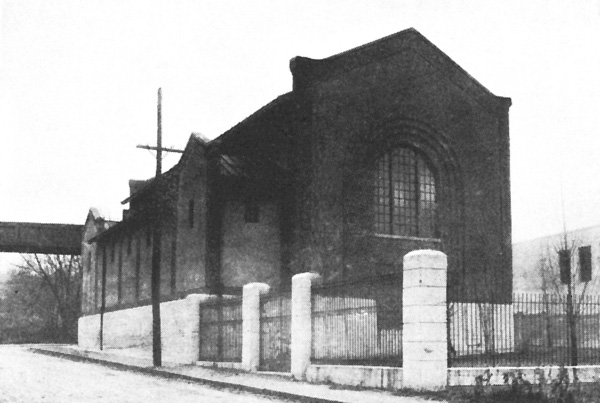
Exterior of Egleston Square Substation
There are in operation for supplying power to both elevated and surface lines a total of 12 synchronous converter substations having a total rated capacity of 58,000 kw. The power consumption of the Rapid Transit lines is somewhat less than half the total energy used.
Direct current is distributed from the several substations at 600 volts and is collected on the rapid transit systems from an 85-lb. over-running third rail.
Altogether there are 420 cars in the rapid transit service, the older cars weighing about 34 tons with seating capacity of 48 and the newer type as used in the Cambridge Subway 43 tons each, arranged to seat 72 passengers. On account of the limiting clearances in the old subway the Cambridge cars cannot be used on the main line. All cars are motor cars and no attempt is made to use trailers. Each car is equipped with two motors and multiple unit control.
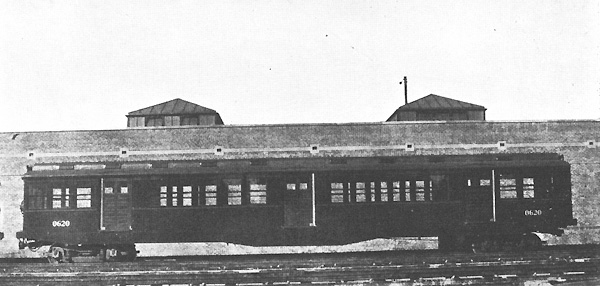
Latest Type of Steel Motor Car Used in Cambridge Subway
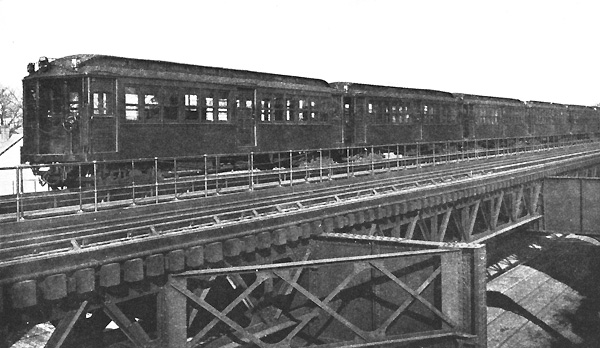
Main Line Train—Boston Elevated Railway
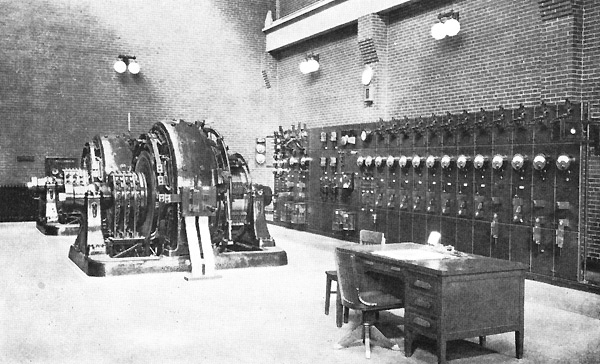
Interior of Substation Equipped with 2000-Kw. Synchronous Converters
The Brooklyn Rapid Transit Company controls all of the elevated and surface lines in Brooklyn including those reaching Coney Island. It also has entrance to Manhattan over the lines of the New York Municipal Railway Corporation, which was organized by the B. R. T. to finance and construct a part of the new city lines allotted to the B. R. T. The New York Municipal line runs through the new Broadway subway as far north as 60th St. thence east through the 60th St. tunnel under the East River to a connection with the Astoria and Corona lines in Queens. Other subway and bridge routes have been completed during the past few years as part of a definite plan, which contemplates the elimination of the present stub end operation at the lower end of Manhattan.

Standard New York Municipal Motor Car Equipped with GE-248 Motors
The Brooklyn Bridge line built in 1883 and the Brooklyn Elevated R. R. in 1888 formed the nucleus of the present Brooklyn Rapid Transit system. Electrical equipment was tried out in 1898 and additional motor cars were put in service in 1902. This improvement rapidly displaced the “steam dummies” and facilitated the extension of lines and the handling of a rapidly increasing traffic.
Of the present lines on the Brooklyn Rapid Transit system 89.20 miles of route aggregating 258.35 miles on a single track basis can be classed as rapid transit lines and operate multiple unit trains with third rail current collection. This includes the several elevated branches in Brooklyn and the newer subway lines of the dual system all of which are operated by the New York Consolidated R. R. Co., which is the operating organization.
The lines of the Brooklyn Rapid Transit system, which are operated by the New York Consolidated R. R., according to figures for the year ended June 30, 1921, handled 404,970,640 passengers over the rapid transit lines.
The original power equipment consisted of engine-driven direct-current generators, which have gradually been retired due to obsolescence.

Rapid Transit Lines Operated by New York Consolidated R. R. Co.
Power for operating the B. R. T. system is now generated in two alternating-current plants with installed capacities as follows:
| Central (Third Av. & 2nd. St.) | 16,500 kw. |
| Williamsburg (Kent Av. & Rush St.) | 182,500 kw. |
9Power is generated and transmitted at 6600 volts, 25 cycles, three-phase. Owing to the diversified feeding system it is not possible to estimate the portion used by the elevated and surface lines. Power for the operation of the Manhattan lines is purchased from the Interborough Rapid Transit Co.
For supplying 600 volts to the entire system the B. R. T. has in operation 98 synchronous converter units aggregating 142,500 kw. These units range in size from 500 to 4000 kw. each. Many of the stations feed both elevated and surface lines so that it is difficult to approximate the capacity available for the rapid transit service.
Current collection on all elevated and subway lines is from an over-running third rail. The following sizes of third rail are in use:
| Early Elevated lines | 55 lb. | (to be replaced with 80 lb.) |
| Subway lines | 80 lb. | |
| New Subway | 150 lb. |
The New York Consolidated R. R. Company operates in subway and elevated service a total of 1550 cars each equipped with two motors and multiple unit control. These include the equipment operated over the New York Municipal lines through the new subways. 900 of the newest cars use GE-248 motors and weigh, fully equipped, about 45 tons with seats for 72 passengers. These new cars are operated in all motor car trains.
Trains up to seven cars are operated in rush hour service and the minimum headways approximate two minutes. The maximum length of ride possible for a single fare is from Corona through the Broadway subway to Coney Island, about 21 miles. The maximum grade on the system is 5 per cent on the New York Municipal line.

4000-Kw. Synchronous Converters Installed in South 6th Street Substation
The present Chicago Elevated Railroads are an amalgamation of the four systems which up to 1911 were operated as independent lines. Under the unified system of operation a single fare takes the passenger from one end of the system to the other, except that north of Howard Street on the Evanston line an additional fare is collected. The longest continuous ride without change is from Wilmette to Jackson Park, a distance of 24 miles.
The first elevated road, afterward known as the South Side Elevated, started operation in June, 1892, with steam engines. After the successful demonstration on the Intramural Railway this line was electrified; all steam equipment being withdrawn in 1898.
What is now the Chicago and Oak Park Elevated Railroad began operation in 1893 also with steam locomotives. Electrical operation began in September, 1896.

30,000-Kw. Curtis Turbine in Northwest Station of Commonwealth Edison Company
11The Metropolitan West Side was originally planned for steam locomotive operation, but developments in electric traction during the construction period were so rapid that orders for steam equipment were cancelled and operation began in May, 1895, with electric equipment.
The Northwestern Elevated began operation in May, 1900, and was planned as an electric rad from the start. In 1897 the “Union Loop” was built to facilitate interchange of passengers from the different lines, but a separate fare was required on each road up to 1913.
The population served by the Chicago Elevated Lines is estimated at more than 1,000,000 people; the total number of passengers handled annually is about 190,000,000. Trains of from six to eight cars are operated during rush hour service on a two-minute headway with a maximum of 72 trains per hour on a track of the loop. Plans are being made to extend some of the station platforms to permit the use of more than 6- and 8-car trains.
An extensive program of improvements to the present rapid transit system has been proposed, but no definite steps have yet been taken toward authorizing the work. These plans include a subway section under the present loop district with several additional elevated lines.
| Route Miles | Single Track Miles | Yard | Total Track | |
|---|---|---|---|---|
| Northwestern Elevated | 19.7 | 52.33 | 9.28 | 61.61 |
| Chicago & Oak Park | 9.32 | 20.38 | 2.28 | 22.66 |
| Metropolitan West Side | 23.83 | 53.63 | 7.78 | 61.41 |
| South Side | 16.15 | 35.99 | 9.97 | 45.96 |
| Loop | 2.12 | 4.72 | .... | 4.72 |
| 91.12 | 167.05 | 29.31 | 196.36 |

Chicago Elevated Railroads
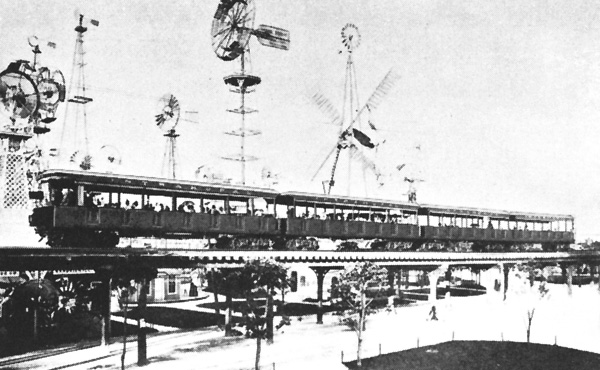
Train on Intramural Railway Chicago, 1893
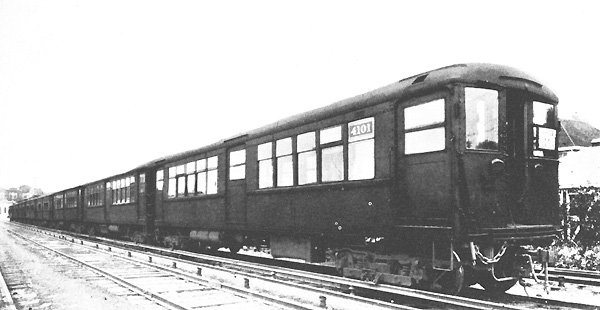
8-car Train—Chicago Elevated Roads—Equipped with GE-243 Motors
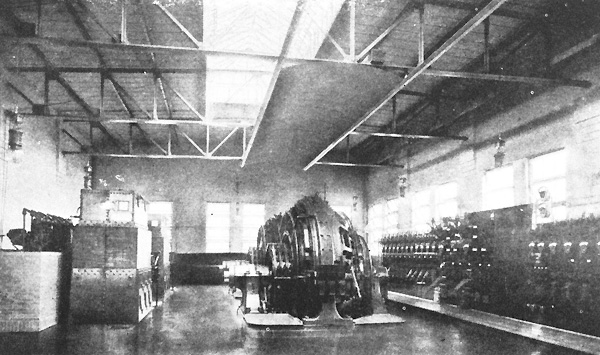
4000-Kw. Synchronous Converters at Campbell Avenue and Homer Street Station
The power for the early elevated lines was derived from engine-driven direct-current power plants all of which have since become obsolete. All power, therefore, is supplied from the network of the Commonwealth Edison Co., which maintains an ample reserve to supply all needs. While a large percentage of the power now being purchased is generated at 25 cycles, the policy of the Power Co. on all new equipment is to specify 60 cycles.
12 out of the 32 substations supplying the various traction systems are owned and operated by the Commonwealth Edison Co. and only 60-cycle generating equipment is installed when adding to their present capacity.
The several substations contain synchronous converter units ranging in size from 1000 to 4000 kw. each. The preferred size for new 60-cycle substations is the 3000-kw. unit of which there are now five in service. The following table shows the ownership and gross capacity of the substation equipment for all of the Chicago lines. It is not possible on account of the diversity of feeding arrangement to designate any particular stations as belonging exclusively to the elevated lines.
| Operating Co. | No. Stations | No. Units | Total Capacity |
|---|---|---|---|
| Chicago Railways Co. | 10 | 32 | 80,000 |
| Chicago City Railway | 7 | 26 | 53,400 |
| Calumet & So. Chicago Railway | 3 | 9 | 9,000 |
| Commonwealth Edison Co. | 12 | 33 | 105,000 |
| Elevated R. R. | 3 | 8 | 9,000 |
| Totals | 35 | 108 | 256,400 |

Latest Type of 3000-Kw., 60-Cycle Synchronous Converters Installed by Commonwealth Edison Company, for Chicago Surface and Elevated Lines
14The Northwestern Elevated R. R. has on order a complete 2000-kw. automatic substation from the General Electric Co. to be installed at Buena Park. This is the first application of the automatic to Metropolitan Rapid Transit service.
Energy for elevated train operation is fed to the third-rail shoes at 600 volts. The third rail is of the top contact unprotected A.S.C.E. rail varying in size from 40 to 80 lb.
The rolling stock equipment includes a total of 1008 two-motor cars weighing from 22 to 35 tons each, the latter figure representing the more recent types of cars. The distribution of these cars among the four divisions is as follows:
| No. Motor Cars | |
|---|---|
| Northwestern Elevated | 302 |
| Chicago & Oak Park Elev. | 84 |
| Metropolitan West Side Elev. | 253 |
| South Side Elev. | 369 |
| Total | 1,008 |
In addition to the motor cars there are available for use on the several divisions about 660 coaches which can be used as trailers.
Supplemental to the regular elevated service the Chicago Elevated System affords entrance to the business section of the city to the Chicago, North Shore & Milwaukee R. R. an affiliated line operating a high speed interurban service between Chicago and Milwaukee. This line enters from the north operating over the Northwestern division at Evanston.
Connection is also made at Des Plaines at the end of the Garfield Park Branch with the Chicago, Aurora & Elgin R. R., a high-speed third-rail line reaching Aurora, Elgin, Batavia, Geneva and other points west. These trains also enter the city running over the Metropolitan West Side tracks into the loop district.

4-car Train on Northwestern Elevated Equipped with GE-243 Motors
The Hudson & Manhattan R. R. Conducts a Heavy Passenger Traffic Between Lower Manhattan and Jersey City points and between an uptown station at 33rd. St. and Hoboken, N. J. Rapid Transit service is also maintained between Hudson Tunnel and Newark over the tracks of the Pennsylvania R. R. These lines popularly known as the Hudson Tubes are to a large extent operated through tunnels under the Hudson River. Direct under-river connection is made between New York and the stations of the Erie, D. L. & W. and Pennsylvania Railroads.
The total mileage of the system is made up as follows:
| Miles of road | 7.869 |
| Extra track | 8.634 |
| Sidings, etc. | .332 |
| Car Houses and Shops | 1.920 |
| Total | 18.768 |
The road was opened in February, 1908, for transportation of passengers from Jersey City to lower Manhattan and later to the uptown terminal.
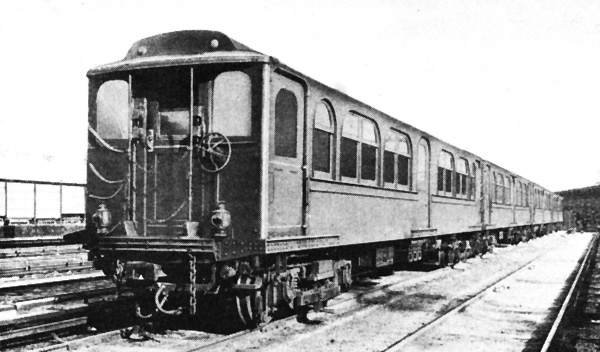
6-car Train on Hudson & Manhattan Railroad Equipped with GE-76 Motors and Type M Control
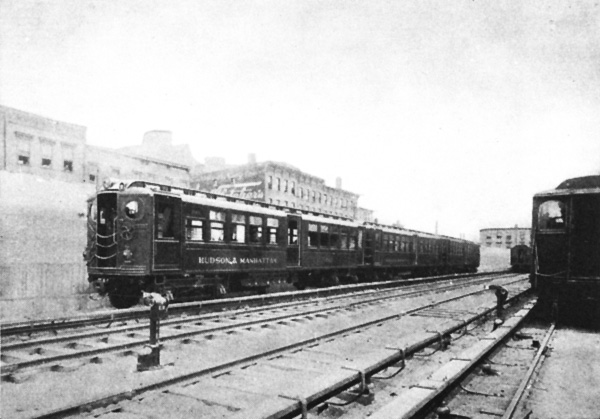
3-car Train for Newark Rapid Transit Service Equipped with GE-212 Motors and Type M Control
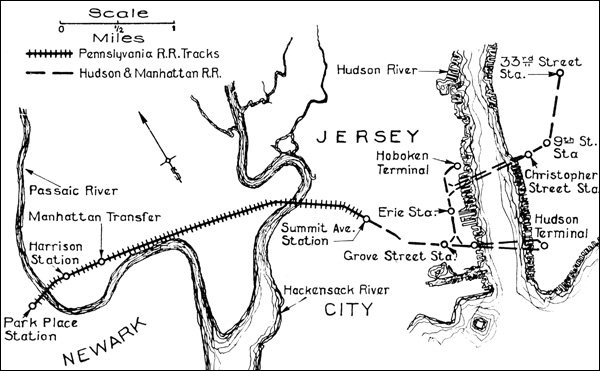
Hudson and Manhattan Railroad
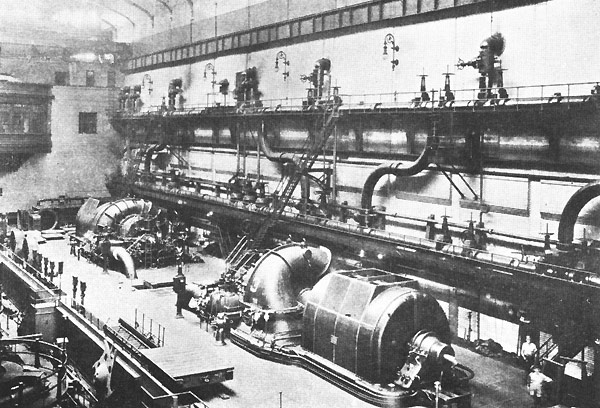
Two 35,000-Kw. Curtis Turbines in Waterside Station No. 1 New York Edison Company
17The electrical equipment, which was furnished throughout by the General Electric Company, includes:
The power station was equipped with two 6000-kw. and two 3000-kw. vertical Curtis turbines generating 25-cycle three-phase alternating current at 11,000 volts. This plant is at Jersey City conveniently located for the reception of coal for fuel and use of Hudson River water for condensing purposes. Through an arrangement agreed to some time ago power is now being purchased from the New York Edison Company, who have furthermore taken over the power station.
Substation No. 1 is located at Christopher & Greenwich Sts.; No. 2 at Washington & First Sts. (in Power House) and No. 3 in the Hudson Terminal Building. The 600-volt current for train propulsion is distributed through a 75-lb. top contact third rail reinforced with suitable feeders.
The motor car equipment owned by the Hudson & Manhattan R. R. includes 251 units, all motor cars, each carrying two motors either GE-76, GE-212 or GE-259 and Type M control. The cars are of all-steel construction and weigh from 35 to 37 tons each without passenger load. The Newark service requires 96 cars of which 36 are owned and 60 are furnished by the Pennsylvania R. R. Co. All of these cars are equipped with GE-212 motors.
Train service is operated on a uniform headway varying the number of cars per train to suit the traffic. Platforms are 370 ft. in length, which is sufficient to accommodate 8-car trains. The total number of passengers handled during the year ended June 30, 1921, was 95,607,645.

On account of its geographical peculiarities the city of New York has for many years been subject to traffic congestion on the north-south line. The long narrow outline of the island of Manhattan with its dense population presents an unusually difficult transportation problem.
Until the year 1914 the operations of the Interborough Rapid Transit System were confined almost exclusively to Manhattan and the Bronx, while the Brooklyn Rapid Transit System operated in Brooklyn and the Borough of Queens. This geographical division, however, was abandoned with the inauguration of the dual system. By the new arrangement the B. R. T. operates into Manhattan over the New York Municipal line and on the other hand the Interborough reaches into Queens through the Steinway Tunnels and the Queensborough Bridge and into Brooklyn by the Eastern Parkway and Nostrand Ave. Lines.
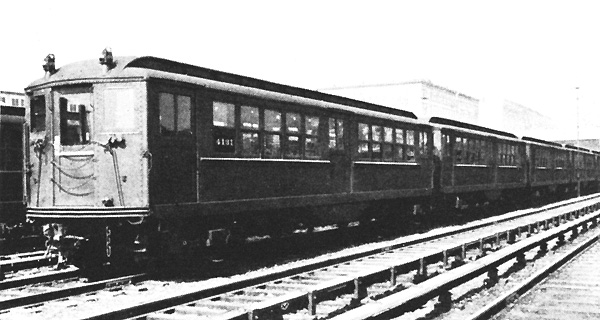
7-car Train Equipped with G-E Motors and PC Control
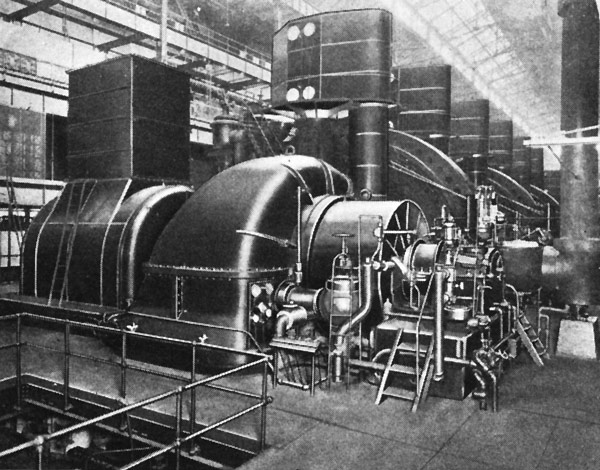
30,000-Kw. Turbine at 59TH Street Station, Interborough Rapid Transit

Interborough Rapid Transit Lines
The Interborough operates the old subway traversing the length of Manhattan and also the four elevated lines in Manhattan and the Bronx. The original lines of this system were built in 1868 and were the first elevated tracks in New York and probably the first in the world. Other elevated lines were built between 1870 and 1880, and the present old subway was completed in 1904-8.
Steam locomotives were superseded on the Manhattan Elevated line in 1902 and electric motor car trains were substituted. The original General Electric equipment installed at that time is still in daily operation after 20 years’ service.
The present rapid transit facilities of the Interborough include the following branches:
| Division | Length of Road | Total Single Track |
|---|---|---|
| Bronx Subway Line Contracts 1 & 2 | ||
| Underground | 19.56 | 62.97 |
| Elevated | 6.16 | 22.32 |
| Contract No. 3 | ||
| Atlantic Ave. | .... | .27 |
| Astoria Line Elevated | 2.33 | 6.87 |
| Brooklyn Line | 5.10 | 17.66 |
| Corona Line Elevated | 4.21 | 12.61 |
| Clark St. Tunnel | 2.31 | 4.67 |
| Jerome Ave. Line | 6.04 | 18.89 |
| Lexington Ave. Line | 5.00 | 21.15 |
| 149th St. Loop | .55 | .55 |
| Nostrand Ave. Branch | 2.70 | 5.55 |
| Pelham Bay Park Line | 7.15 | 21.6 |
| Queensboro Subway | ||
| Underground | 1.61 | 5.98 |
| Elevated | 1.03 | .... |
| South Ave. Line Underground | 4.19 | 15.73 |
| White Plains Rd. Line Elevated | 4.88 | 15.82 |
| Manhattan Division Elevated | 37.67 | 113.19 |
| 8th Ave. & 162nd. St. Connection | .62 | 1.26 |
| Queensboro Bridge Line | 1.35 | 2.73 |
| Webster Ave. Line | 1.74 | 5.33 |
| West Farms Subway Connection | .5 | 1.00 |
| Totals | 114.7 | 373.15 |
The number of passengers carried by the Interboro Lines during the fiscal year 1921 was 1,013,678,831. This figure represents 2,773,479 passengers per mile of track. In the main 4-track subway 10-car express trains are operated during rush hour periods on minimum headways of 108 seconds.
The power generating equipment of the Interborough includes briefly the following:
| 59th St. Power Station | Total Kw. | ||
|---|---|---|---|
| Turbo-Generators | 3-30,000 kw. | 90,000 | |
| Compound Units | 5-15,000 kw. | 75,000 | |
| Engine-driven Units | 4-7,500 kw. | 30,000 | |
| Total | 195,000 | Kw. | |
| 74th St. Power Station | Total Kw. | ||
|---|---|---|---|
| Turbo-Generator | 1-60,000 kw. | 60,000 | |
| Turbo-Generators | 3-30,000 kw. | 90,000 | |
| Turbo-Generator | 1-7,500 kw. | 7,500 | |
| Engine-driven | 3-7,500 kw. | 22,500 | |
| Total | 180,000 | Kw. | |
21Power is generated 11,000 volts three-phase 25 cycles and transmitted principally underground at 11,000 and 19,000 volts. The total energy generated in the two main sections at 59th St. and 74th St. for the year 1921 was 830,000,000 kw-hrs.
For supplying 625-volt direct current to the rapid transit lines, there are a total of 25 substations containing 129 synchronous converters aggregating 283,000 kw.
Propulsion current is delivered to trains through an unprotected over-running third rail weighing, in the old subway 75 lbs. per yard, on the elevated 100 lbs., and in the new subway 150 lbs. per yard.
The motor car equipment on the Manhattan Elevated lines includes over 800 cars which have been in operation since 1902-4 with GE-66 motors and Type M control. These cars after 20 years of hard service are referred to as the “back-bone of the system.” Frequent additions have been made to elevated and subway equipment so that the total rolling stock at the end of the fiscal year 1921 was as follows:
| Manhattan Division | |
| Passenger Motor Cars | 1016 |
| Passenger Trailers | 721 |
| Service Motor Cars | 4 |
| Service Trailers | 56 |
| Elevated Extensions | |
| Passenger Motor Cars | 476 |
| Subway Division Contracts 1 & 2 | |
| Passenger Motor Cars | 785 |
| Passenger Trailers | 352 |
| Service Motor Cars | 10 |
| Service Trailers | 46 |
| Subway Division Contract 3 | |
| Passenger Motor Cars | 581 |
| Passenger Trailers | 217 |
| Service Motor Cars | 1 |
| Total Motor Cars | 2873 |
| Total Trailers | 1392 |
| Grand Total | 4265 |
The longest ride on the system for a single fare is from the terminus of the White Plains Road line at 241st St. near the Northern boundary of the city, the entire length of Manhattan and the Bronx and through the Eastern Parkway Subway to Linwood Avenue, a distance of about 26 miles. The maximum grades encountered are 4½ per cent.
The present rapid transit facilities of the City of Philadelphia include Market St. Subway-Elevated line extending East from the 69th St. Terminal to the Delaware River. The tracks are elevated from 66th St. to 22nd St. and pass in subway under the business section to another elevated section on Delaware Ave. This line first began service in 1905 and during the year 1920 handled approximately 80,000,000 passengers.
As far back as 1912 an exhaustive study of the city’s transportation facilities was made and a comprehensive program of extensions was proposed for the rapid transit system. Owing to legislative delays, and conditions due to the war, progress has been delayed on this program so that so far only the Frankford Elevated line has been built. This is now nearly ready for operation, from the foot of Market Street to Frankford, a distance of 6.4 miles all double tracked. Other extensions planned for construction in the near future include a four-track subway running north and south under Broad Street, and an elevated line extending from the present Market Street line at West Philadelphia to Darby.
The present elevated-subway system is double tracked throughout and multiple unit trains up to seven cars each are operated on headways down to two minutes. No express service is operated, all trains making every stop.

Philadelphia Rapid Transit Elevated and Subway Lines
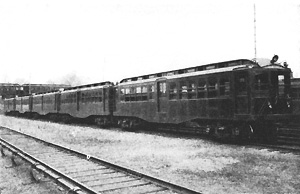
Train on Market Street Elevated, Philadelphia Rapid Transit Company
The Philadelphia Rapid Transit Company’s principal power station is at Delaware Avenue. Steam turbine generating equipment totalling 58,000 kw. is in service in three stations and is designed for 13,200 volts 3-phase 25 cycles at which it is transmitted to the substations. One or two direct-current stations are still available for supplying 600 volts direct to the trolley. Power is also purchased from the Philadelphia Electric Co. and the Philadelphia Hydro-Electric Co.
The company operates a total of 17 substations used for supplying both surface and rapid transit lines. These stations contain a total of 65 units aggregating 103,500 kw.
Power is distributed to all lines at 600 volts and on the rapid transit lines is collected from an under running third rail similar to that used on the New York Central Electric Zone.
The rolling stock used on the Elevated-Subway line includes 215 motor cars each equipped with two motors. Trains are made up of all motor cars, no trailers being used. General Electric motors are used throughout including GE-66 and GE-222. The Frankford extension will be operated with 100 motor cars each equipped with two GE-259 motors.
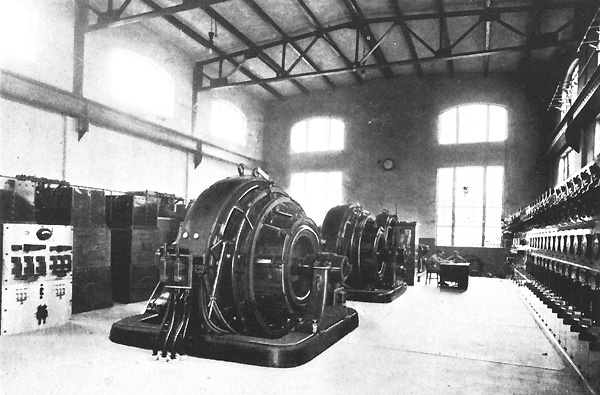
Interior of Substation at 15th and Tucker Streets, Showing 2000-Kw. Synchronous Converters
SYSTEM |
Cars | Motors | |||||
|---|---|---|---|---|---|---|---|
| No. | Yr. put in Service | Total Wgt. Pounds | Length Overall Ft. In. |
No. | Type | Trailer Operating | |
| Boston Elev. Rwy. Co. | 40 | 1917 | 66383 | 46 7¼ | 2 | GE-259-B | } |
| 45 | 1920 | 66628 | 46 7¼ | 2 | GE-259-B | } No | |
| 24 | 1920 | 68009 | 46 7¼ | 2 | GE-259-B | } | |
| 20 | 1912-3 | 86400 | 69 6½ | 2 | GE-212 | } | |
| Hudson & Manhattan R. R. | 50 | 1907 | 74550 | 48 3 | 2 | GE-76 | } |
| 90 | 1909 | 69620 | 48 5 | 2 | GE-76 | } | |
| 50 | 1910 | 69620 | 48 5 | 2 | GE-76 | } No | |
| 96 | 1911 | 73000 | 48 3½ | 2 | GE-212-C | } | |
| 25 | 1921 | 73500 | 51 3½ | 2 | GE-259 | } | |
| Interborough Rapid Transit Co. | 828 | 1902-3 | 75500 | 47 0½ | 2 | GE-66-A | } |
| 200 | 1904 | 58500 | 47 0½ | 2 | GE-69-B | } | |
| 91 | 1907 | 59160 | 47 0½ | 2 | GE-211-A | } | |
| 40 | 1907 | 83200 | 47 0½ | 2 | GE-212-A | } | |
| 190 | 1909 | 83200 | 51 0½ | 2 | GE-212-A | } Yes | |
| 6 | 1915 | 70960 | 51 0½ | 2 | GE-240-C | } | |
| 161 | 1915 | 75000 | 51 0½ | 2 | GE-259-A | } | |
| 103 | 1915 | 75500 | 51 0½ | 2 | GE-260-A | } | |
| 71 | 1915 | 71000 | 51 0½ | 2 | GE-259-A | } | |
| 168 | 1917 | 75500 | 51 0½ | 2 | GE-260-A | } | |
| Metropolitan West Side Elev. Rwy. | 12 | 1895-98 | 65000 | 47 9½ | 2 | GE-2000 | } |
| 78 | 1904 | 65-70000 | 47 9½ | 2 | GE-55 | } Yes | |
| 37 | 1914-5 | 70000 | 48 6¾ | 2 | GE-243 | } | |
| Northwestern Elev. R. R. | 192 | 1900-06 | 65-69000 | 46 7½ | 2 | GE-55 | } |
| 20 | 1908 | 69000 | 46 7½ | 2 | GE-211-B | } Yes | |
| 43 | 1914-15 | 70000 | 48 6¾ | 2 | GE-243 | } | |
| South Side Elev. R. R. | 149 | 1897 | 52714 | 47 1 | 2 | GE-57-B | } |
| 70 | 1902-03 | 55000 | 47 3 | 2 | GE-73-A | } Yes | |
| 61 | 1914-15 | 70000 | 48 6¾ | 2 | GE-243 | } | |
| Chicago & Oak Park Elev. R. R. | 84 | 1906 | 65-70000 | 46 7½ | 2 | GE-55 | Yes |
| N. Y. Municipal Ry. | 900 | 1914-20 | 90600 | 67 0 | 2 | GE-248 | Yes |
| Philadelphia Rapid Tran. Co. | 40 | 1906 | 71000 | 49 7 | 2 | GE-66 | } |
| 40 | 1907 | 76000 | 49 7 | 2 | GE-66 | } | |
| 16 | 1906 | 72000 | 49 7 | 2 | GE-66 | } | |
| 4 | 1909 | 76000 | 49 7 | 2 | GE-66 | } No | |
| 65 | 1911 | 70500 | 49 7 | 2 | GE-66 | } | |
| 50 | 1913 | 70000 | 49 7 | 2 | GE-222-F | } | |
| 50 | 1921 | 89600 | 55 | 2 | GE-259 | } | |
| 50 | 1922 | 89600 | 55 | 2 | GE-259 | } | |
Bulletin Number 49 is a reproduction of a 1922 General Electric Company pamphlet. Since that year many changes have been made in the systems described and new lines have been constructed in Cleveland, Toronto and Montreal. Another is under construction in the San Francisco area. Additional copies are available at $1.50 each from the Electric Railway Historical Society, Box 3305, Chicago, Ill. 60654.
End of the Project Gutenberg EBook of Metropolitan Subway and Elevated
Systems, by General Electric Company
*** END OF THIS PROJECT GUTENBERG EBOOK METROPOLITAN SUBWAY ***
***** This file should be named 54009-h.htm or 54009-h.zip *****
This and all associated files of various formats will be found in:
http://www.gutenberg.org/5/4/0/0/54009/
Produced by Juliet Sutherland, ellinora and the Online
Distributed Proofreading Team at http://www.pgdp.net
Updated editions will replace the previous one--the old editions
will be renamed.
Creating the works from public domain print editions means that no
one owns a United States copyright in these works, so the Foundation
(and you!) can copy and distribute it in the United States without
permission and without paying copyright royalties. Special rules,
set forth in the General Terms of Use part of this license, apply to
copying and distributing Project Gutenberg-tm electronic works to
protect the PROJECT GUTENBERG-tm concept and trademark. Project
Gutenberg is a registered trademark, and may not be used if you
charge for the eBooks, unless you receive specific permission. If you
do not charge anything for copies of this eBook, complying with the
rules is very easy. You may use this eBook for nearly any purpose
such as creation of derivative works, reports, performances and
research. They may be modified and printed and given away--you may do
practically ANYTHING with public domain eBooks. Redistribution is
subject to the trademark license, especially commercial
redistribution.
*** START: FULL LICENSE ***
THE FULL PROJECT GUTENBERG LICENSE
PLEASE READ THIS BEFORE YOU DISTRIBUTE OR USE THIS WORK
To protect the Project Gutenberg-tm mission of promoting the free
distribution of electronic works, by using or distributing this work
(or any other work associated in any way with the phrase "Project
Gutenberg"), you agree to comply with all the terms of the Full Project
Gutenberg-tm License (available with this file or online at
http://gutenberg.org/license).
Section 1. General Terms of Use and Redistributing Project Gutenberg-tm
electronic works
1.A. By reading or using any part of this Project Gutenberg-tm
electronic work, you indicate that you have read, understand, agree to
and accept all the terms of this license and intellectual property
(trademark/copyright) agreement. If you do not agree to abide by all
the terms of this agreement, you must cease using and return or destroy
all copies of Project Gutenberg-tm electronic works in your possession.
If you paid a fee for obtaining a copy of or access to a Project
Gutenberg-tm electronic work and you do not agree to be bound by the
terms of this agreement, you may obtain a refund from the person or
entity to whom you paid the fee as set forth in paragraph 1.E.8.
1.B. "Project Gutenberg" is a registered trademark. It may only be
used on or associated in any way with an electronic work by people who
agree to be bound by the terms of this agreement. There are a few
things that you can do with most Project Gutenberg-tm electronic works
even without complying with the full terms of this agreement. See
paragraph 1.C below. There are a lot of things you can do with Project
Gutenberg-tm electronic works if you follow the terms of this agreement
and help preserve free future access to Project Gutenberg-tm electronic
works. See paragraph 1.E below.
1.C. The Project Gutenberg Literary Archive Foundation ("the Foundation"
or PGLAF), owns a compilation copyright in the collection of Project
Gutenberg-tm electronic works. Nearly all the individual works in the
collection are in the public domain in the United States. If an
individual work is in the public domain in the United States and you are
located in the United States, we do not claim a right to prevent you from
copying, distributing, performing, displaying or creating derivative
works based on the work as long as all references to Project Gutenberg
are removed. Of course, we hope that you will support the Project
Gutenberg-tm mission of promoting free access to electronic works by
freely sharing Project Gutenberg-tm works in compliance with the terms of
this agreement for keeping the Project Gutenberg-tm name associated with
the work. You can easily comply with the terms of this agreement by
keeping this work in the same format with its attached full Project
Gutenberg-tm License when you share it without charge with others.
1.D. The copyright laws of the place where you are located also govern
what you can do with this work. Copyright laws in most countries are in
a constant state of change. If you are outside the United States, check
the laws of your country in addition to the terms of this agreement
before downloading, copying, displaying, performing, distributing or
creating derivative works based on this work or any other Project
Gutenberg-tm work. The Foundation makes no representations concerning
the copyright status of any work in any country outside the United
States.
1.E. Unless you have removed all references to Project Gutenberg:
1.E.1. The following sentence, with active links to, or other immediate
access to, the full Project Gutenberg-tm License must appear prominently
whenever any copy of a Project Gutenberg-tm work (any work on which the
phrase "Project Gutenberg" appears, or with which the phrase "Project
Gutenberg" is associated) is accessed, displayed, performed, viewed,
copied or distributed:
This eBook is for the use of anyone anywhere at no cost and with
almost no restrictions whatsoever. You may copy it, give it away or
re-use it under the terms of the Project Gutenberg License included
with this eBook or online at www.gutenberg.org/license
1.E.2. If an individual Project Gutenberg-tm electronic work is derived
from the public domain (does not contain a notice indicating that it is
posted with permission of the copyright holder), the work can be copied
and distributed to anyone in the United States without paying any fees
or charges. If you are redistributing or providing access to a work
with the phrase "Project Gutenberg" associated with or appearing on the
work, you must comply either with the requirements of paragraphs 1.E.1
through 1.E.7 or obtain permission for the use of the work and the
Project Gutenberg-tm trademark as set forth in paragraphs 1.E.8 or
1.E.9.
1.E.3. If an individual Project Gutenberg-tm electronic work is posted
with the permission of the copyright holder, your use and distribution
must comply with both paragraphs 1.E.1 through 1.E.7 and any additional
terms imposed by the copyright holder. Additional terms will be linked
to the Project Gutenberg-tm License for all works posted with the
permission of the copyright holder found at the beginning of this work.
1.E.4. Do not unlink or detach or remove the full Project Gutenberg-tm
License terms from this work, or any files containing a part of this
work or any other work associated with Project Gutenberg-tm.
1.E.5. Do not copy, display, perform, distribute or redistribute this
electronic work, or any part of this electronic work, without
prominently displaying the sentence set forth in paragraph 1.E.1 with
active links or immediate access to the full terms of the Project
Gutenberg-tm License.
1.E.6. You may convert to and distribute this work in any binary,
compressed, marked up, nonproprietary or proprietary form, including any
word processing or hypertext form. However, if you provide access to or
distribute copies of a Project Gutenberg-tm work in a format other than
"Plain Vanilla ASCII" or other format used in the official version
posted on the official Project Gutenberg-tm web site (www.gutenberg.org),
you must, at no additional cost, fee or expense to the user, provide a
copy, a means of exporting a copy, or a means of obtaining a copy upon
request, of the work in its original "Plain Vanilla ASCII" or other
form. Any alternate format must include the full Project Gutenberg-tm
License as specified in paragraph 1.E.1.
1.E.7. Do not charge a fee for access to, viewing, displaying,
performing, copying or distributing any Project Gutenberg-tm works
unless you comply with paragraph 1.E.8 or 1.E.9.
1.E.8. You may charge a reasonable fee for copies of or providing
access to or distributing Project Gutenberg-tm electronic works provided
that
- You pay a royalty fee of 20% of the gross profits you derive from
the use of Project Gutenberg-tm works calculated using the method
you already use to calculate your applicable taxes. The fee is
owed to the owner of the Project Gutenberg-tm trademark, but he
has agreed to donate royalties under this paragraph to the
Project Gutenberg Literary Archive Foundation. Royalty payments
must be paid within 60 days following each date on which you
prepare (or are legally required to prepare) your periodic tax
returns. Royalty payments should be clearly marked as such and
sent to the Project Gutenberg Literary Archive Foundation at the
address specified in Section 4, "Information about donations to
the Project Gutenberg Literary Archive Foundation."
- You provide a full refund of any money paid by a user who notifies
you in writing (or by e-mail) within 30 days of receipt that s/he
does not agree to the terms of the full Project Gutenberg-tm
License. You must require such a user to return or
destroy all copies of the works possessed in a physical medium
and discontinue all use of and all access to other copies of
Project Gutenberg-tm works.
- You provide, in accordance with paragraph 1.F.3, a full refund of any
money paid for a work or a replacement copy, if a defect in the
electronic work is discovered and reported to you within 90 days
of receipt of the work.
- You comply with all other terms of this agreement for free
distribution of Project Gutenberg-tm works.
1.E.9. If you wish to charge a fee or distribute a Project Gutenberg-tm
electronic work or group of works on different terms than are set
forth in this agreement, you must obtain permission in writing from
both the Project Gutenberg Literary Archive Foundation and Michael
Hart, the owner of the Project Gutenberg-tm trademark. Contact the
Foundation as set forth in Section 3 below.
1.F.
1.F.1. Project Gutenberg volunteers and employees expend considerable
effort to identify, do copyright research on, transcribe and proofread
public domain works in creating the Project Gutenberg-tm
collection. Despite these efforts, Project Gutenberg-tm electronic
works, and the medium on which they may be stored, may contain
"Defects," such as, but not limited to, incomplete, inaccurate or
corrupt data, transcription errors, a copyright or other intellectual
property infringement, a defective or damaged disk or other medium, a
computer virus, or computer codes that damage or cannot be read by
your equipment.
1.F.2. LIMITED WARRANTY, DISCLAIMER OF DAMAGES - Except for the "Right
of Replacement or Refund" described in paragraph 1.F.3, the Project
Gutenberg Literary Archive Foundation, the owner of the Project
Gutenberg-tm trademark, and any other party distributing a Project
Gutenberg-tm electronic work under this agreement, disclaim all
liability to you for damages, costs and expenses, including legal
fees. YOU AGREE THAT YOU HAVE NO REMEDIES FOR NEGLIGENCE, STRICT
LIABILITY, BREACH OF WARRANTY OR BREACH OF CONTRACT EXCEPT THOSE
PROVIDED IN PARAGRAPH 1.F.3. YOU AGREE THAT THE FOUNDATION, THE
TRADEMARK OWNER, AND ANY DISTRIBUTOR UNDER THIS AGREEMENT WILL NOT BE
LIABLE TO YOU FOR ACTUAL, DIRECT, INDIRECT, CONSEQUENTIAL, PUNITIVE OR
INCIDENTAL DAMAGES EVEN IF YOU GIVE NOTICE OF THE POSSIBILITY OF SUCH
DAMAGE.
1.F.3. LIMITED RIGHT OF REPLACEMENT OR REFUND - If you discover a
defect in this electronic work within 90 days of receiving it, you can
receive a refund of the money (if any) you paid for it by sending a
written explanation to the person you received the work from. If you
received the work on a physical medium, you must return the medium with
your written explanation. The person or entity that provided you with
the defective work may elect to provide a replacement copy in lieu of a
refund. If you received the work electronically, the person or entity
providing it to you may choose to give you a second opportunity to
receive the work electronically in lieu of a refund. If the second copy
is also defective, you may demand a refund in writing without further
opportunities to fix the problem.
1.F.4. Except for the limited right of replacement or refund set forth
in paragraph 1.F.3, this work is provided to you 'AS-IS' WITH NO OTHER
WARRANTIES OF ANY KIND, EXPRESS OR IMPLIED, INCLUDING BUT NOT LIMITED TO
WARRANTIES OF MERCHANTABILITY OR FITNESS FOR ANY PURPOSE.
1.F.5. Some states do not allow disclaimers of certain implied
warranties or the exclusion or limitation of certain types of damages.
If any disclaimer or limitation set forth in this agreement violates the
law of the state applicable to this agreement, the agreement shall be
interpreted to make the maximum disclaimer or limitation permitted by
the applicable state law. The invalidity or unenforceability of any
provision of this agreement shall not void the remaining provisions.
1.F.6. INDEMNITY - You agree to indemnify and hold the Foundation, the
trademark owner, any agent or employee of the Foundation, anyone
providing copies of Project Gutenberg-tm electronic works in accordance
with this agreement, and any volunteers associated with the production,
promotion and distribution of Project Gutenberg-tm electronic works,
harmless from all liability, costs and expenses, including legal fees,
that arise directly or indirectly from any of the following which you do
or cause to occur: (a) distribution of this or any Project Gutenberg-tm
work, (b) alteration, modification, or additions or deletions to any
Project Gutenberg-tm work, and (c) any Defect you cause.
Section 2. Information about the Mission of Project Gutenberg-tm
Project Gutenberg-tm is synonymous with the free distribution of
electronic works in formats readable by the widest variety of computers
including obsolete, old, middle-aged and new computers. It exists
because of the efforts of hundreds of volunteers and donations from
people in all walks of life.
Volunteers and financial support to provide volunteers with the
assistance they need, are critical to reaching Project Gutenberg-tm's
goals and ensuring that the Project Gutenberg-tm collection will
remain freely available for generations to come. In 2001, the Project
Gutenberg Literary Archive Foundation was created to provide a secure
and permanent future for Project Gutenberg-tm and future generations.
To learn more about the Project Gutenberg Literary Archive Foundation
and how your efforts and donations can help, see Sections 3 and 4
and the Foundation web page at http://www.pglaf.org.
Section 3. Information about the Project Gutenberg Literary Archive
Foundation
The Project Gutenberg Literary Archive Foundation is a non profit
501(c)(3) educational corporation organized under the laws of the
state of Mississippi and granted tax exempt status by the Internal
Revenue Service. The Foundation's EIN or federal tax identification
number is 64-6221541. Its 501(c)(3) letter is posted at
http://pglaf.org/fundraising. Contributions to the Project Gutenberg
Literary Archive Foundation are tax deductible to the full extent
permitted by U.S. federal laws and your state's laws.
The Foundation's principal office is located at 4557 Melan Dr. S.
Fairbanks, AK, 99712., but its volunteers and employees are scattered
throughout numerous locations. Its business office is located at
809 North 1500 West, Salt Lake City, UT 84116, (801) 596-1887, email
business@pglaf.org. Email contact links and up to date contact
information can be found at the Foundation's web site and official
page at http://pglaf.org
For additional contact information:
Dr. Gregory B. Newby
Chief Executive and Director
gbnewby@pglaf.org
Section 4. Information about Donations to the Project Gutenberg
Literary Archive Foundation
Project Gutenberg-tm depends upon and cannot survive without wide
spread public support and donations to carry out its mission of
increasing the number of public domain and licensed works that can be
freely distributed in machine readable form accessible by the widest
array of equipment including outdated equipment. Many small donations
($1 to $5,000) are particularly important to maintaining tax exempt
status with the IRS.
The Foundation is committed to complying with the laws regulating
charities and charitable donations in all 50 states of the United
States. Compliance requirements are not uniform and it takes a
considerable effort, much paperwork and many fees to meet and keep up
with these requirements. We do not solicit donations in locations
where we have not received written confirmation of compliance. To
SEND DONATIONS or determine the status of compliance for any
particular state visit http://pglaf.org
While we cannot and do not solicit contributions from states where we
have not met the solicitation requirements, we know of no prohibition
against accepting unsolicited donations from donors in such states who
approach us with offers to donate.
International donations are gratefully accepted, but we cannot make
any statements concerning tax treatment of donations received from
outside the United States. U.S. laws alone swamp our small staff.
Please check the Project Gutenberg Web pages for current donation
methods and addresses. Donations are accepted in a number of other
ways including checks, online payments and credit card donations.
To donate, please visit: http://pglaf.org/donate
Section 5. General Information About Project Gutenberg-tm electronic
works.
Professor Michael S. Hart is the originator of the Project Gutenberg-tm
concept of a library of electronic works that could be freely shared
with anyone. For thirty years, he produced and distributed Project
Gutenberg-tm eBooks with only a loose network of volunteer support.
Project Gutenberg-tm eBooks are often created from several printed
editions, all of which are confirmed as Public Domain in the U.S.
unless a copyright notice is included. Thus, we do not necessarily
keep eBooks in compliance with any particular paper edition.
Most people start at our Web site which has the main PG search facility:
http://www.gutenberg.org
This Web site includes information about Project Gutenberg-tm,
including how to make donations to the Project Gutenberg Literary
Archive Foundation, how to help produce our new eBooks, and how to
subscribe to our email newsletter to hear about new eBooks.